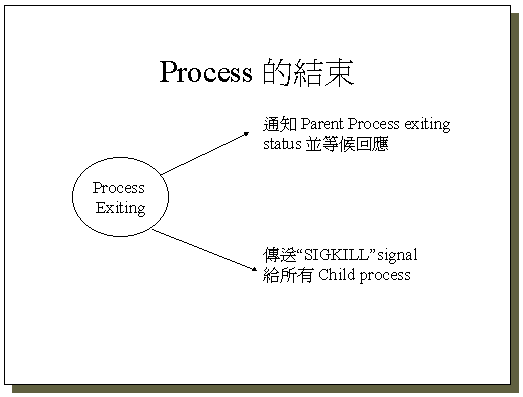這似乎要從這邊開始解釋
什麼是程序 (process)
在 Linux 系統當中:『觸發任何一個事件時,系統都會將他定義成為一個程序,並且給予這個程序一個 ID ,稱為 PID,同時依據啟發這個程序的使用者與相關屬性關係,給予這個 PID 一組有效的權限設定。』 從此以後,這個 PID 能夠在系統上面進行的動作,就與這個 PID 的權限有關了!

fork是UNIX一個系統呼叫(system call),process fork時,會複製一個跟自己完全一模一樣的process (with different pid),並利用系統呼叫完成之傳回值,來區分parent process 與child process,而分別賦予child process不同的功能

基本宣告:
pid_t ford(void) // creat child process
RETURN VALUE
On success, the PID of the child process in returned in the parent, and 0 is returned in the child. On failure, -1 is returned in the parent, no child process is created, and errno is set appropriately.
果然還是英文解釋比較簡單明瞭,意思就是process執行成功之後,回傳的值的類型....
1. 如果是child process執行成功,就回傳 0
2. 如果是parent process執行成功,就回傳child process的PID
3. 如果出現錯誤(大概是指有process執行錯誤或是產生child process失敗吧!),則回傳的值為 -1
Example: fork1.c
#include <unistd.h> // 要宣告這個 header file,這樣 pid_t 才會被認得
#include <stdio.h>
main()
{
pid_t pid_test;
pid_test=fork(); // 執行完這行,就會產生出一個child process
//這時就有parent process和child process同時在運行
if (pid_test < 0) //表示有錯誤發生
printf("error in fork!");
else if (pid_test == 0) // 表示child process執行成功
printf("I am the child process, ID is %d\n", getpid());
else // 表示parent process執行成功
printf("I am the parent process, ID is %d\n", getppid());
}
RETURN VALUE
On success, the PID of the child process in returned in the parent, and 0 is returned in the child. On failure, -1 is returned in the parent, no child process is created, and errno is set appropriately.
果然還是英文解釋比較簡單明瞭,意思就是process執行成功之後,回傳的值的類型....
1. 如果是child process執行成功,就回傳 0
2. 如果是parent process執行成功,就回傳child process的PID
3. 如果出現錯誤(大概是指有process執行錯誤或是產生child process失敗吧!),則回傳的值為 -1
Example: fork1.c
#include <unistd.h> // 要宣告這個 header file,這樣 pid_t 才會被認得
#include <stdio.h>
main()
{
pid_t pid_test;
pid_test=fork(); // 執行完這行,就會產生出一個child process
//這時就有parent process和child process同時在運行
if (pid_test < 0) //表示有錯誤發生
printf("error in fork!");
else if (pid_test == 0) // 表示child process執行成功
printf("I am the child process, ID is %d\n", getpid());
else // 表示parent process執行成功
printf("I am the parent process, ID is %d\n", getppid());
}
執行結果:
>gcc fork1.c -o fork1
I am the parent process, ID is 3403
I am the child process, ID is 11571
I am the child process, ID is 11571
Note:
- 這只是基本解釋,至於fork在linux中的真正作用為何,還需要找資料來了解和補充
參考資料:
1. 鳥哥的Linux私房菜
http://linux.vbird.org/linux_basic/0440processcontrol.php
沒有留言:
張貼留言